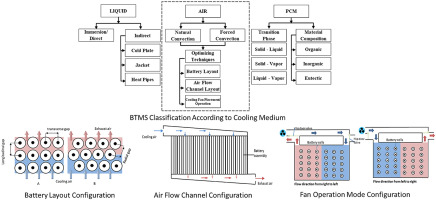Renewable and Sustainable Energy Reviews ( IF 16.3 ) Pub Date : 2020-03-18 , DOI: 10.1016/j.rser.2020.109815 A.A. Hakeem Akinlabi , Davut Solyali

|
A battery thermal management system (BTMS) is arguably the most vital component of an electric vehicle (EV), as it is responsible for ensuring the safe and consistent performance of lithium ion batteries (LiB). LiBs are considered one of the most suitable power options for an EV drivetrain. Owing to lithium's atomic number of three (3) and it being the lightest element of the metals, lithium is able to provide fantastic energy-to-weight characteristics for any lithium-based battery. LiBs are also known for having low self-discharging properties and hence provide long life cycle operation. To obtain a maximum power output from LiBs, it is necessary to critically monitor the operating conditions of LiBs, particularly temperature, which is known to directly affect the performance and life of LiBs. The temperature rise present around LiBs is caused by the heat generation phenomena of lithium ion cells during charge and discharge cycles. In this study, an investigation is made into one of the major categories of a BTMS, used in making the EV powertrain much more efficient and safe. Specifically, this study investigates and reviews air-cooled BTMS techniques (passive and active) and design parameter optimization methods (either via iteration or algorithms) for improving various BTMS design objectives. In particular, this study investigates minimizing the change in temperature among cells (ΔTmax) in a battery pack (BP). The data are classified, and results from recent studies on each method are summarized. It is found that despite features such as extreme simplicity, ease of implementation, and the relatively low cost of naturally air-cooled BTMS, it is almost impossible for the methods to provide adequate cooling conditions for the high energy density LiBs used in EVs. A shift in focus from a naturally air-cooled BTMS to a forced air-cooled BTMS is observed from the amount of studies found on the topics during the time scope of this study. Parameter configuration optimization techniques for the air-cooled BTMS are discussed and classified, and optimization algorithms applied by researchers to improve objectives of the BTMS are identified.
中文翻译:

电动汽车风冷电池热管理系统的配置,设计和优化:综述
电池热管理系统(BTMS)可以说是电动汽车(EV)最重要的组成部分,因为它负责确保锂离子电池(LiB)的安全和一致的性能。LiB被认为是EV动力传动系统最合适的动力选择之一。由于锂的原子序数为三(3),并且它是金属中最轻的元素,所以锂能够为任何锂基电池提供出色的能量重量特性。LiB也因具有低自放电特性而闻名,因此可提供较长的使用寿命。为了从LiB获得最大功率输出,有必要严格监控LiB的工作条件,特别是温度,众所周知,温度直接影响LiB的性能和寿命。LiB周围存在的温度升高是由锂离子电池在充电和放电循环期间的发热现象引起的。在这项研究中,我们对BTMS的主要类别之一进行了调查,以使EV动力总成更加高效和安全。具体而言,本研究调查和审查了风冷BTMS技术(被动和主动)和设计参数优化方法(通过迭代或算法),以改善各种BTMS设计目标。特别是,这项研究调查了如何将细胞之间的温度变化降至最低(这项研究调查并审查了风冷BTMS技术(被动和主动)和设计参数优化方法(通过迭代或算法),以改善各种BTMS设计目标。特别是,这项研究调查了如何将细胞之间的温度变化降至最低(这项研究调查并审查了风冷BTMS技术(被动和主动)和设计参数优化方法(通过迭代或算法),以改善各种BTMS设计目标。特别是,这项研究调查了如何将细胞之间的温度变化降至最低(ΔT最大值)的电池组(BP)。对数据进行分类,并对每种方法的最新研究结果进行总结。已经发现,尽管具有诸如极度简单,易于实施以及自然风冷BTMS的相对较低成本的特征,但是该方法几乎不可能为电动汽车中使用的高能量密度LiB提供足够的冷却条件。在本研究的时间范围内,从有关主题的研究数量来看,观察到从自然风冷BTMS转向强制风冷BTMS的转变。对风冷BTMS的参数配置优化技术进行了讨论和分类,并确定了研究人员为提高BTMS目标而应用的优化算法。











































 京公网安备 11010802027423号
京公网安备 11010802027423号